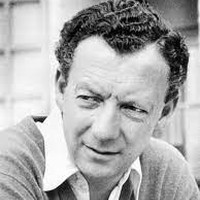Haydn’s Oxford Symphony



(Duration: 14 min)
Benjamin Britten had a precocious start in music, studying piano and viola and composing hundreds of works by the time he was a teenager. At fourteen, Britten’s viola teacher introduced him to the composer Frank Bridge, who agreed to give Britten private lessons. “I, who thought I was already on the verge of immortality, saw my illusions shattered,” Britten later wrote about his course of study with Bridge, a demanding teacher who fostered the rigorous technique needed to round out Britten’s natural inventiveness. Britten went on to enroll at the Royal Conservatory of Music in 1930, and even if he chafed at the conservative approach of his teachers, he was able to fill in the gaps by devouring recent music by Stravinsky, Schoenberg and other modernists.
Britten’s career began to take off in 1932, when a prize-winning Phantasy for string quartet led to his first professional performance. That same summer he took three weeks to compose the Sinfonietta, the work that would become his first published opus. The scoring for ten solo instruments (a woodwind quintet plus a string quintet) reflects the influence of Schoenberg’s First Chamber Symphony, a seminal work for such mixed ensembles. The dissonant harmonies and spiky phrases in the opening movement also point to young Britten’s fascination with Continental modernism, but still the music retains Britten’s intuitive feel for melody, as heard in the mellifluous woodwind phrases and crystalline violin duet in the central movement. A trembling viola line links directly to the Tarantella, a kinetic finale in the manner of the Italian folk dance named, so it is said, for the manic gyrations intended to ward off death after the bite of a tarantula.
Aaron Grad ©2023

Shostakovich traveled to Dresden in July 1960 to work on a film called Five Days—Five Nights, commemorating the devastation of that German city during World War II. Once there, his muse led him in an unexpected direction. He explained in a letter to a friend, “However much I tried to draft my obligations for the film, I just couldn’t do it. Instead I wrote an ideologically deficient quartet nobody needs. I reflected that if I die someday, then it’s hardly likely anyone will write a work dedicated to my memory. So I decided to write one myself. You could even write on the cover: ‘Dedicated to the memory of the composer of this quartet.’”
With Shostakovich’s blessing, the Russian conductor and violist Rudolf Barshai adapted that work from Dresden, the String Quartet No. 8, into this Chamber Symphony in C Minor, Opus 110a. The intensely personal nature of the music is evident from the very first notes: they spell out D–E-flat–C–B, or, in German parlance, D–S–C–H, signifying the composer’s first initial and last name. This motto theme had appeared in earlier compositions, but here the motive’s lugubrious rise and fall becomes a morbid obsession. The score also quotes other Shostakovich works, with passages referencing the First and Fifth Symphonies and the Second Piano Trio. The work unfolds as a continuous arc of five connected movements, opening and closing in a slow Largo tempo and encompassing central episodes of greater urgency and agitation.
Aaron Grad ©2018

After decades of being locked into an exclusive contract with Austria’s Esterházy family, Haydn negotiated new terms in 1779 that gave him more leeway to compose and publish independently. He was already immensely popular around Europe thanks to the many pirated scores in circulation, and under his new terms he could finally capitalize on his fame, like when he accepted a commission in 1785 to write six new symphonies for a young French count, Claude-François-Marie Rigolet. The same count requested three more symphonies that Haydn completed by 1789, including the Symphony No. 92, the last of that set.
Haydn composed the Symphony No. 92 for Paris, and not Oxford, despite the nickname. Having accepted an invitation to present concerts in London in 1791, Haydn brought some of his existing symphonies to perform while he was working to write new ones—an endeavor that eventually produced twelve “London” symphonies over the course of two visits. The Symphony No. 92 was among the music that Haydn conducted when he accepted an honorary doctorate from Oxford University.
Like most of its successors composed for London, the “Oxford” Symphony builds anticipation with a slow introduction. With subtle harmonic subterfuge and not-so-subtle dynamic jolts, the fast body of the movement is a model example of Haydn’s fluidity within the fixed structure of a sonata-allegro form.
One of the most effective sounds in Haydn’s arsenal is a sudden, unexpected silence, a device that lends extra poignancy near the end of the slow second movement, and which arises again throughout the playful Minuetto. With a dramatic application of formal counterpoint, the finale made this symphony an especially strong pick to impress the academic crowd at Oxford.
Aaron Grad ©2018
Get driving directions and find nearby parking.
Find dining options close to the venue.
View seating charts to find out where you'll be seating.
SPCO concerts are made possible by audience contributions.
For exclusive discounts, behind-the-scenes info, and more:
Sign up for our email club!
